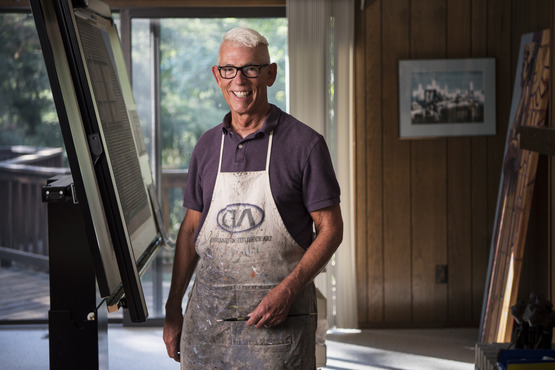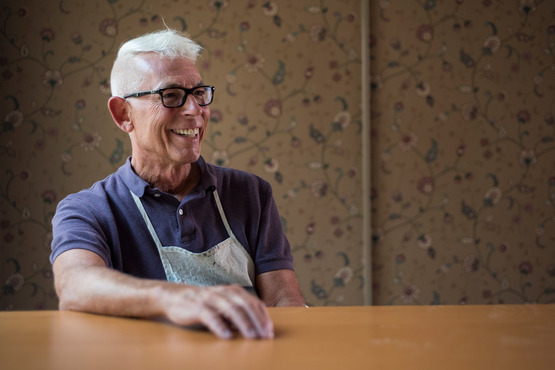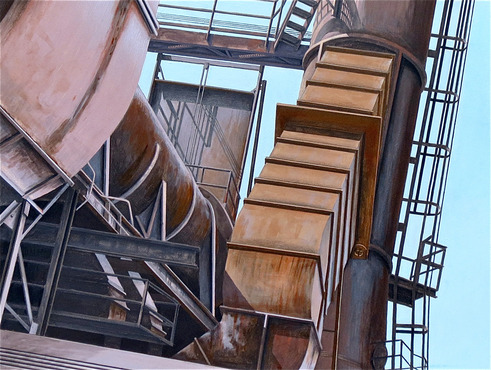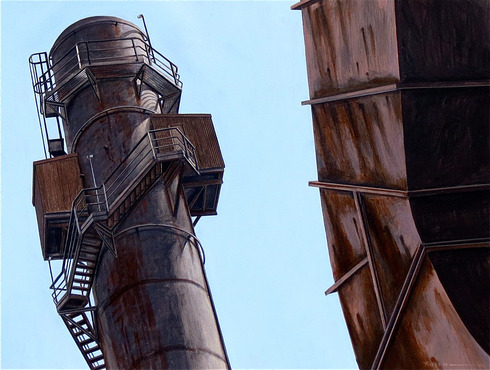
News . Feature Stories . Making meaning
News
August 25, 2016
Making meaning
Roese fulfills enduring wish to help young artists find their way

In his Treehouse Studio in Strongsville, Tom Roese uses graphite and paint to make architecturally based works. Photo by Jerry Birchfield.
By Karen Sandstrom
To understand why it was important for Tom Roese to plan a legacy gift to the Cleveland Institute of Art, it helps to know what he was thinking when he started his career in art education.
Roese ’71, a newly minted CIA graduate, had decided to add a teaching certificate to his bachelor of fine arts degree. In a classroom at Cleveland State University, the education instructor asked for a show of hands from everyone who wanted to be a teacher because they just loved kids.
All around him were colleagues who hoped to teach elementary school. Hands shot up. Roese thought, “That’s not me.” The teacher quickly congratulated the reticent students. “The five of you who didn’t raise your hands have made the right choice,” she told them. Their passion for their subject matter, she added, would serve their pupils well.
For 30 years, Roese poured that passion for art into his career. Through an ongoing studio practice, he built a catalog of drawings and paintings that celebrate the built environment around Cleveland. And in his career as a high school art teacher, he took seriously his task to make life better — for the sullen lug in the corner who didn’t think he wanted to be in art class, for the winsome young woman who secretly traced his demonstration drawings so she could make hers better, and for the social outcasts just trying to get through day to day. Especially for them.
“I became a teacher in high school,” Roese says. He remembers what it was like to be a gay kid trying to go unnoticed. It didn’t always work. He was slammed into lockers. “Gym class was just a horror. All of high school was hell,” he says.
“After I got out and got to art school, it got better,” Roese says. “I saw how different that was. It was so much easier, because it was like home, and everybody was an art kid.”
Roese soon understood that becoming a teacher might enable him to help students who were suffering as he had. “I didn’t want to become a high school teacher to promote being gay, but I could be there to see a kid who’s struggling and kind of help them with that struggle.”
Roese taught high school art in the Parma City Schools, where he retired in 2002. (He also taught at CIA for decades through Continuing Education.)
He had long hoped to fund some sort of scholarship at CIA — maybe for a semester or so. In working with CIA’s Institutional Advancement department, he realized he could establish an endowed scholarship that would be renewed annually. “This is fabulous,” he says. “This is what I’ve always wanted to do.”
Roese also was able to design the scholarship so that it would be awarded to an LGBTQ student during sophomore, junior and senior year.
“Tom is a true CIA success story,” says Grafton Nunes, CIA President + CEO. “Through his work as a fine artist and educator, he built a career that allowed him to make lasting meaning for himself and others. I’m so inspired by his steadfast dedication to young artists. His gift will support not just their education, but it will also help expand an environment here at CIA that encourages every student to thrive as creators and as community members.”
If life as a high school kid was tough, his life now is, he says, beautiful. Last year, Roese and his longtime partner, Bill Franklin, married in what was, by all counts, a moving ceremony at Fairmount Temple.
With his teaching career behind him, Roese has more time to spend at Treehouse Studios, the Strongsville townhouse where there’s always a work in progress on his easel. His sensitive, dynamic drawings and paintings of rust-belt-era buildings and bridges begin with photos Roese takes in the field.
“When I photograph, right then and there I’m composing in the camera — I’m starting the drawing,” he says. “And I’m editing prior to that. As I’m looking casually at the landscape, I’m thinking that would be interesting.”
Back in the studio, he hones the compositions, then prints his images and begins to draw. “There are times when I put things in that don’t exist. Telephone poles are a prime example. I put them in sometimes for balance, for color, for textures, or to bring something into the foreground, or to break up the sky or add textural interest. There was a period when I was putting animals in. It was fun to see, where could I put an animal that would make sense.”
Rarely does a human figure show up on the canvas or paper, but the human element is always present. “I like to have you think that by having no person, the presence of the person is even stronger,” Roese says. “For me, a lot of it is the story of who built that building or that lift bridge. Who designed that bridge? Who decided that bridge should be there?”
He remembers riding his bike around town on a sweltering Cleveland day and wanting to shake off the heat and humidity that clung to him like a bad suit. He imagined the kind of guy who had to toil on the construction of the lift bridge before him. He, too, would’ve been tortured by the heat, but there he’d be, working to feed his family.
“The only way you can do it is by putting that lousy rivet in there when it’s 85 degrees with 95 percent humidity and you’re wearing it like clothing that weighs a ton,” Roese says. “To me, that’s what that bridge is about.”
Where to see Tom Roese artwork
THE COLORS OF ARCHITECTURE
Works on Canvas
September 9 through October 31
Trudy Wiesenberger Gallery
University Hospitals of Cleveland
11100 Euclid Ave., Cleveland 44106
32nd Annual Fine Print Fair
Presented by the Print Club of Cleveland
September 22-25, 2016
Cleveland Museum of Art
11150 East Blvd., Cleveland 44106
Latest Headlines view all
-
April 02, 2024
Cleveland Institute of Art students partner with Progressive Art Collection to exhibit Ready, Set, Relay! -
March 04, 2024
Cleveland Institute of Art announces Curlee Raven Holton Inclusion Scholar Program -
November 06, 2023
Collision of art and artificial intelligence creates murky waters for artists, curators and educators
Questions?
For more information about this or other CIA news, contact us here.








Social Feed